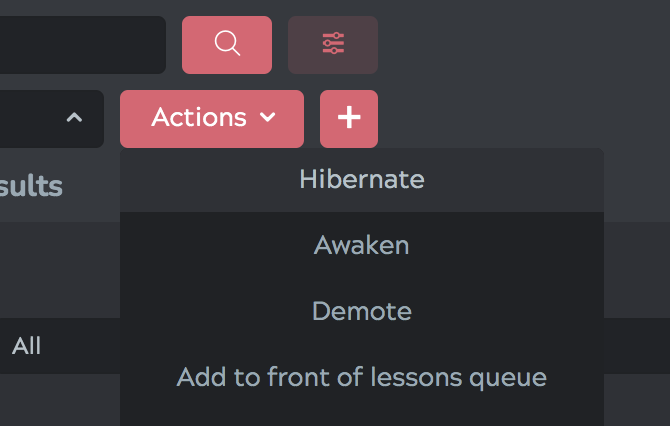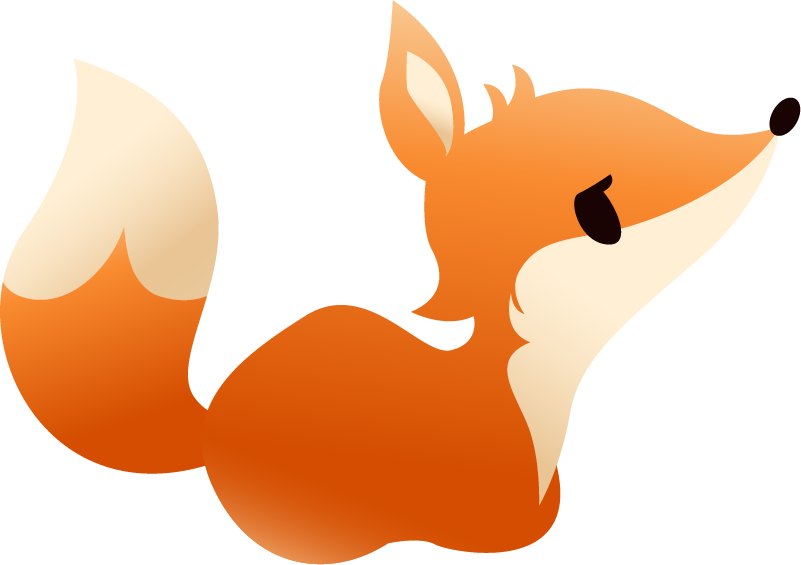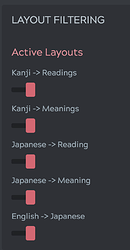I was wondering, you guys who are WK 60, do you already know all of these radicals ? https://jisho.org/#radical
Or will the remaining be covered with this deck ?
Or there will still be some missing ?
@1117, if you know WK radicals (and kanji), then you know the radicals listed here in this deck. Most overlap to this Jisho list but some have a different breakdown. For the deck in some entries, it was more elegant to break down by existing kanji rather than reverting back to smaller radicals. I’m not teaching the radical names separately, that’s WK’s property but the radical knowledge we learned is ours. If you are coming from an outside platform, it may be adaptable or just really weird (I’d be curious to know). The shape to the mnemonics are now matched in the entry to follow along so maybe ok.
I checked the first line against the WK beyond deck which has 1000+ based new newspaper frequency and found only 12/32 to be on their list. I’m not convinced adding the full Jinmeiyo list as above is time well spent where usage varies widely. I’d be more interested to be sure if we are covered at least up until level 2 Kanken for any Jinmeiyo that may be missing; which I hope would be close if their count ~2300 and this full list (w/ WK) is ~2400. There is also the matter of confirm the nanori reading and common example usage.
Thank you for your answer.
I’m using this https://jisho.org/#radical tool to look for new kanji that I encounter in my reading so I wondered if I will learn all of these radicals along my WK journey.
I’m far from the level 60 at the moment and it’s a pain to check the radicals presence by myself since I can’t ctrl+f them on wkstats for instance (because of the slight variations of their writing, or some seem to be plain images).
I wondered maybe you already checked these when building this deck to make sure you got all of them since you already learned a bunch of radicals on WK and can do it by sight.
Though I’m not sure about why you talked about adding the full Jinmeiyo list since I was just talking about radicals (unless that part wasn’t for me  )
)
This has been talked about on WK boards and I think WK took some liberties in a few radicals in an effort to consolidate the mnemonic system. However I haven’t come across a kanji where I haven’t been able to use WK radicals to create a mnemonic in this deck, though there a few exceptions where radical breakdown was less efficient. Nonetheless, I never found the need to check outside radical lists
I happened to be writing this based on another discussion to my earlier thread post when responding to you (separate topic, sorry for any confusion  )
)
Alright thanks for your answers 
I’ve started using the deck and noticed two thinks I had questions on.
-
Once the kanji are rank 3, it unlocks the vocab for the kanji. This normally doesn’t happen in Wanikani until rank 5. Is there a way to adjust that or is it just how Kitsunio works?
-
The unlocked vocab words seem to be in the lessons pile before new kanji. Is there a way to push the vocab until after you learn all the kanji for a level?
Hello @donut223 ,
It sounds like you may not be using the hibernate/tag feature as your lessons are q’ing randomly. This will ensure kanji study for the level is done before vocab.
This is how I used the deck:
The deck is divided by either kanji or vocab template, each corresponds to the kanji or vocab list
- Select all card

-
Hibernate all cards (both kanji and vocab list, have to do separately)

-
Select ‘level’ of choice (L61) and click advance search
- Awaken your filtered level

Now you just have L61 kanji to work on. When you want to release the L61 vocab, you can ‘awaken’ the vocab via the tag filter whenever you want. I usually do it whenever my kanji lesson are done (there is no auto release like wk based on ‘guru’ status). I’m not speed-running so they are usually ‘guru’d’ anyways. But the bonus is there is no gatekeeping and you can go at whatever pace you want. And of course, all vocab is optional; I tried to pick relevant vocab but slimmer choices at this stage and will hibernate some words myself. The filter tool is power feature in Kitsun, you can built your ‘known’ word list and it allows decking jumping without overlap of already studied words.
Hope this was clear, apologies if this is already known and I missed the mark on the answer you are looking for.
Hi @s1212z
I appreciate the explanation and photos. I’m new to Kitsunio so I was aware of the list and I saw the options (hibernate, awaken, etc) but I wasn’t sure what they were so I didn’t want to mess the deck up with them too much. Your explanation at least helped me with my hesitation to change settings on the cards. I did hibernate all the vocab and then the kanji then awakened the L61 kanji so I’ll see how that goes. Once the kanji are done, I’ll awaken the L61 vocab (right? Just making sure).
Thanks again! 
Ok, great! Glad it was helpful.
Yes, you can awaken the L61 vocab when your kanji lessons are done to have the same WK-like experience. Can even use it as a kanji only deck if preferred. Another tip in case you were not aware, you can enable (or disable) if you want Eng -> Jp recall so you can have a kaniwani effect in the same review or have it like WK for reading/meaning only
Yeah I saw that Eng > Jp option as I perused the options and turned it on.
Is it possible to reset the 5 vocab words I learned before I put the vocab words to hibernate so I can learn them later once the kanji are done?
Yeah, you can use ‘demote’ and set the level you want (it’s in the screen capture from above under ‘awaken’)
I noticed there’s two 儒 (Confucian) under the kanji deck. They both look to be exactly the same.
Thx! Thought I remember there being two long ago and it was deleted but guess not.
I marked the 2nd one for deletion so feel free to hibernate it until then. Also consolidated two options for mnemonic in original entry.
I guess I’ll be your tester for the deck because I think I found another problem lmao
While doing level 61 vocab, I came across the word 侃侃諤諤 and… I’ve never seen 諤 anywhere and its not in your kanji deck either lol. Maybe add it as a kanji into a level prior to the vocab word?
(Also, I hope none of this is coming off as hating or saying the deck is bad. I just want it better for others <3)
If you look up 侃 in Kitsun (Jisho), there are only two entries: 侃侃諤諤 and 侃直 so not a lot of options for kanji reinforcement. The idea is to give users extra practice or give a user the option to practice whatever they want…at least we are not forced fed like WK to learn vocab we don’t want in order to proceed. So much like I mentioned earlier, I will scope the vocab list as I’m opening a new level and see what vocab I want to use or not as there no obligation to use anything whatsoever.
The scope of the deck is to cover the remaining Joyo and N1 kanji based on WK stats. If I start adding 諤, the deck becomes something different so I won’t add it. In my personal deck, I know I have hundreds of kanji not in WK or LL. And truthfully, mosts don’t have a separate kanji card to learn as I find the vocab word itself as the most essential piece. From a user’s perspective, I’d say you can either accept 侃直 as your only vocab reinforcement and hibernate 侃侃諤諤 or accept both…or add 諤 to a personal deck. But checking with a native, they were neither familiar with 侃侃諤諤 or 諤々 (it’s not in the ‘Beyond WK’ deck of 999 kanji either) so it returns to a common WK issue of “why am I learning this useless word?” just for the sake of a kanji that may or may not be useful…but who knows, it may come up in odd ways so may be worth learning (thus a deck card option). Speculatively, an educated native probably knows well beyond 3000+ so obviously this deck will not cover near to that extent (just for realistic expectations).
No worries, if there are useful vocab to add that is not listed to help reinforce a kanji, I’m happy to add it and can do quickly (no extensive team meeting required  )
)
Sounds good. Yeah it seems like 諤 is very uncommon so your explanation makes sense. I will for now just hibernate it and circle back around to it later. I’m just very much in the flow of “Learn Kanji” > “Learn Vocab with kanji I already know” but obviously others can do what they want. If I see more like that in the future, I’ll just hibernate them for later. Thanks being being quick to respond 
Thanks for the attention to details, the feedback helps everyone that uses it. It sparked me to check the lists again and there were a few other doubles due to shared vocab on different levels that I didn’t notice. @Neicudi for a few for ‘mark for deletion’.
One minor inconsistency I noticed. The audio for the vocab card 鴻 says おおとり but the reading given is ひしくい. Not sure which one you wanted as the technically correct answer lol.
These are all auto generated by Kitsun (via Google’s API I believe) so I don’t select or upload anything for choice. I tried downloading Google translation mp3 but was running into issues. So if anyone has a source, I’m happy to upload a new audio file.
I do see quirks in the audio file through the platform though mostly are correct. It doesn’t understand natural intonation so not something I rely on but better nothing.



